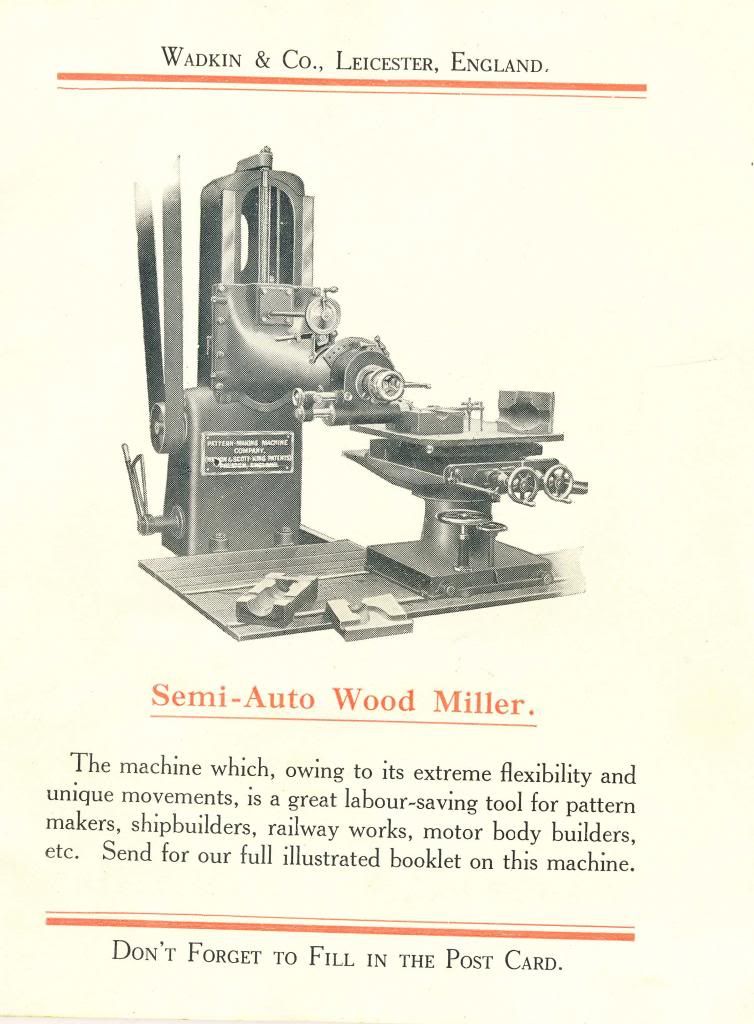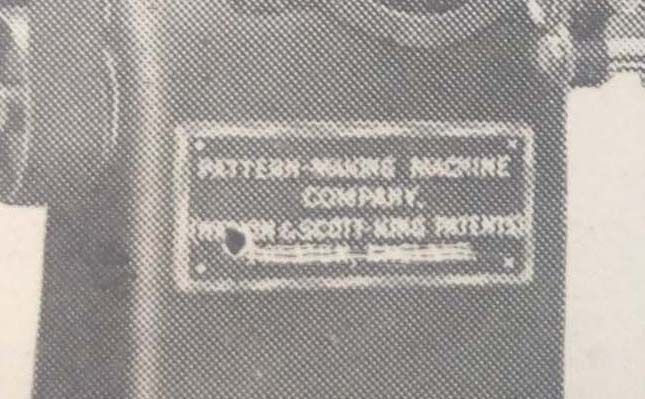 Thanks: 0
Thanks: 0
 Needs Pictures: 0
Needs Pictures: 0
 Picture(s) thanks: 0
Picture(s) thanks: 0
Results 1 to 6 of 6
Thread: Wadkin pattern mill c1911.
-
26th March 2013, 10:52 PM #1
 Wadkin pattern mill c1911.
Wadkin pattern mill c1911.
Pics of mill in the old tram workshop at Randwick Sydney.
The mill is now in storage elsewhere.
H.
-
26th March 2013 10:52 PM # ADSGoogle Adsense Advertisement
- Join Date
- Always
- Location
- Advertising world
- Posts
- Many
-
31st December 2013, 08:55 AM #2
 Another in Ipswitch.
Another in Ipswitch.
Looks like its brother is up there in Ipswitch from the old railway foundry. See Barker double disc posting.
Some info from Modern Mechanical Engineering 1923 The Gresham Publishing Co.
This is the first machine Wadkin made.
Very collectable in the US or UK I'm sure.
Probably go to scrap in Oz.
H.Jimcracks for the rich and/or wealthy. (aka GKB '88)
-
31st December 2013, 04:03 PM #3
 SENIOR MEMBER
SENIOR MEMBER











- Join Date
- Nov 2011
- Location
- Newcastle NSW
- Posts
- 775

Hey Henry,
Thanks for sharing, you definately have a good eye. I have looked at the Pickles and double disc sander a few times (they have listed them a few times now), but I didn't notice the pattern mill in the background.
If your date of 1911 is accurate, then this machine may actually preceed it?? Found this in a little 1922 Wadkin Catalogue I picked up a few months back (very early catalogue considering it is from NZ). It shows the Semi-Auto Wood Miller, one thing I did find interesting is the plate (second picture shows a closer look).


It says "Pattern Making Machine Company. Wadkin & Scott-King Patents." Interestingly they have then scratched off the printers etching showing the manufacture location in England (presumably they had moved production locations, but had not got around to making a new machine plate for the photo).
I managed to find the patent for it US934484 shrunk.pdf giving it a patent date of 1909 (application date of 22nd August 1908).
The earliest Wadkin machine???
Cheers,
Camo
-
31st December 2013, 04:25 PM #4
 SENIOR MEMBER
SENIOR MEMBER











- Join Date
- Nov 2011
- Location
- Newcastle NSW
- Posts
- 775

And to answer my own question (amazing what a google search will get you
 ). Your one was the earlier, this is the patent US885408.pdf, applied for in 1905.
). Your one was the earlier, this is the patent US885408.pdf, applied for in 1905.
Cheers,
Camo
-
31st December 2013, 06:08 PM #5
 Wadkin history
Wadkin history
Hi Cam,
I saw that Wadkin cat also on trade me but left it to you to chase.
Even stranger the Modern Engineering book I bought in Nelson on our recent NZ trip.
I haven' seen that particular mill before. Would like a deko at the rest of that catalogue.
I have never seen the original Mechanical Woodworker in any posts on any old machinery sites so these in Oz may be the only survivors.
I thought abut chasing it but don't really have the room, sure as I get it the Sydney one will turn up.
They cleared the workshop where it was stored and I can't track it down as yet.
I heard from an old machinery dealer that there was one on the Titanic when she went down?
H.
HistoryA new company which was established three years before the end of the century was formed by Joseph William Wadkin (1862 1919) to manufacture his newly invented pattern miller. He is believed to have started in 1897 with seven men. A note-paper is still in existence dated 1898. This note-paper is headed with an illustration of his London Street, Leicester factory. Wadkin & Co. is first recorded in Wright’s Leicester Directory for 1900.Last Modified: Feb 20 2012 9:00PM by Jeff_Joslin
If you have information to add to this entry, please contact the Site Historian.
By 1904 Wadkin was making a range of single purpose machines presumably primarily so that he could completely equip pattern shops in addition to supplying his pattern milling machine and this, of course, led to a wider market. He took out a U.K. patent in 1901 and a U.S.A patent in 1907 for a machine he described as a “Mechanical Woodworker” which could do any operation in “Pattern Work also Joinery and cabinet work” outside conventional ripping, planing and thicknessing, due to its universal spindle and table movement. A number of post cards are still in existence which he sent to members of his family from Brussles, Clogne, Basle and St Petersburgh between 1906 and 1909 whilst travelling on business. In the one form St Petersburgh (Leningrad) in 1906, he comments “I have just seen the Villa where at a reception by the Minister of the interior, 23 people were blown up by a bomb. The Minister escaped but his daughter was killed the centre of the Villa is a total wreck. This happened on a Saturday afternoon just before I arrived”.
Wadken & Co. evidently promoted their mechanical woodworker over a wide area of Europe and the USA. The American franchise was given to the Oliver Machinery Company Grand Rapids Michigan in 1908. There is an illustrated article in the May 1909 issue of the American Journal in “The Foundry” describing the machine in considerable detail, which concludes “ this machine is made by Wadkin & Co., Evington Engineering Works, Leicester, England, and is sold by the Oliver Machinery Company Grand Rapids Michigan U.S.A.”. Wadkin was probably the first U.K woodworking machinery maker to actually promote sales of U.K woodworking machinery in the States and in Russia.
Joesph Wadkin is shown in the wright directory as being in Partnership by 1900 with Densil John Jarivs, who was married to his sister. Mr Jarvis is shown in late 19th Century directories as a shop fitter and builder of shop fronts for which he had his own company D.J. Jarvis and Co. By 1908 this partnership was dissolved and Joseph Wadkin left the Company which he had founded and went into Partnership with Thomas Scott-King they patented together a new machine to “produce irregular forms which will stand relative to all other single function wood working machines as the universal milling machine stands to all other metal working machines”. This machine was substantially similar in its outline to the present day Wadkin WX pattern milling machine.
In 1912 Densil Jarvis was lost in the Titanic disaster and the ownership of the original small Wadkin Company passed into other hands who built the Company up to be one of the world’s leaders in woodworking machinery.
Whilst Joseph Wadkin offered his machine with attachments for many varied operations, it was probably always mostly sold to pattern shops and shipbuilders. As a consequence Wadkin’s customers were not primarily woodworkers, but engineers who well understood machinery. For the first time therefore, woodworking machinery had to be built to satisfy enginners and this was the start of woodworking machinery built to machine tool standards. In retrospect this was probably more important to the long term interest of the industry than the invention of the pattern miller. Joseph Wadkin with Thomas Scott-King started a company in Nottingham known as Wadkin Mills, which after his death from pneumonia in March 1919 was sold to his original company.
Following the death of Densil Jarvis in the Titanic disaster as described (previously) he small Wadkin company was taken over by J.Wallis-Goddard, a manufacturing chemist in Leicester who owned the firm manufacturing Plate Powders. Mr Goddard’s eldest son, Joseph Holland Goddard. had emigrated to America via Canada and was in the process of becoming an American citizen, at this time when his father invited him to return to this country and manage the Wadkin Company. The invitation was accepted and until 1927 when J.W. Goddard died, the Wadkin letter heading showed the father and son as partners. Within two years after J.H. Goddard had taken over the management from the later Denzil Jarvis in 1912, the FIrst World War broke out. J.H. Goddard immediately joined up. He was commissioned and served the whole length of the War as a despatch rider in France. The business in the meantime was managed by senior employees. He returned to full management in 1919 to find the Company with enormous order books quite beyond their limited production capacity. Sub contractors were use to cope with the immediate situation; one supplier was the Preston Woodworking Machinery Co. of Canada. The two Goddard’s planned and built a new factory at Green Lane Road, Leicester. The factory was equipped with the latest single purpose machine tools for batch production. By 1922 the book following the First World War was over, and in 1923 J.H. Goddard started on a World tour to set p agents and build a substantial export business for their U.K machines, the principal one of which the Pattern Miller. The range included one or two specialist machines, such as the wood propeller shaper developed during the War, and a range of single purpose basic woodworking machines. This tour encircled the world and makes selling history because of its mammoth duration without his return, lasting two and a half years. The first country to be visited was India in November 1923. This was followed by visits to Ceylon, Singapore. Java, Australia, New Zealand, Hong Kong, Shanghai, Japan, Canada and the U.S.A. Some of the countries particularly Australia and New Zealand, were visited more than once. Agencies would be set up, machines ordered for stock from the U.K and then the country would be revisited to ensure that the stock was satisfactory and sales were being made. The last report from Mr. Goddard is dated April 1926 and was written from New York prior to sailing to England. He was back again in Canada and the U.S.A by September 1926, checking up on the agents performance and attending the Foundry Convention in Detroit, where the Pattern Miller was on show. He finally returned to England in January 1927 after selling several Pattern Millers during the final U.S.A visit.Jimcracks for the rich and/or wealthy. (aka GKB '88)
-
1st January 2014, 05:00 PM #6
 SENIOR MEMBER
SENIOR MEMBER











- Join Date
- Nov 2011
- Location
- Newcastle NSW
- Posts
- 775

Some great information, if memory serves me correct (and I am fairly confident it does), that information was actually provided to Jeff Joslin by none other than our very own Melbourne Matty. Matty referenced the details from his copy of the William Simms book. If I am correct that Matty wrote it, and I am almost 100% certain I am, they really should have credited him for his input, not just as it is the right thing to do, but also (in my opinion) it would add to the credibility of the information (hard to find someone with a better collection of source material).
Cheers,
Camo
Similar Threads
-
Wadkin Radial Saw
By Morbius in forum ANTIQUE AND COLLECTABLE TOOLSReplies: 5Last Post: 3rd July 2013, 06:33 AM -
Wadkin RAS
By pmcgee in forum ANTIQUE AND COLLECTABLE TOOLSReplies: 1Last Post: 5th October 2012, 09:52 PM -
Wadkin machinery
By pmcgee in forum ANTIQUE AND COLLECTABLE TOOLSReplies: 16Last Post: 4th September 2012, 01:04 PM -
Wadkin in the wild
By jgforsberg in forum ANTIQUE AND COLLECTABLE TOOLSReplies: 13Last Post: 3rd September 2012, 08:51 PM



 Likes:
Likes: 
 Reply With Quote
Reply With Quote

